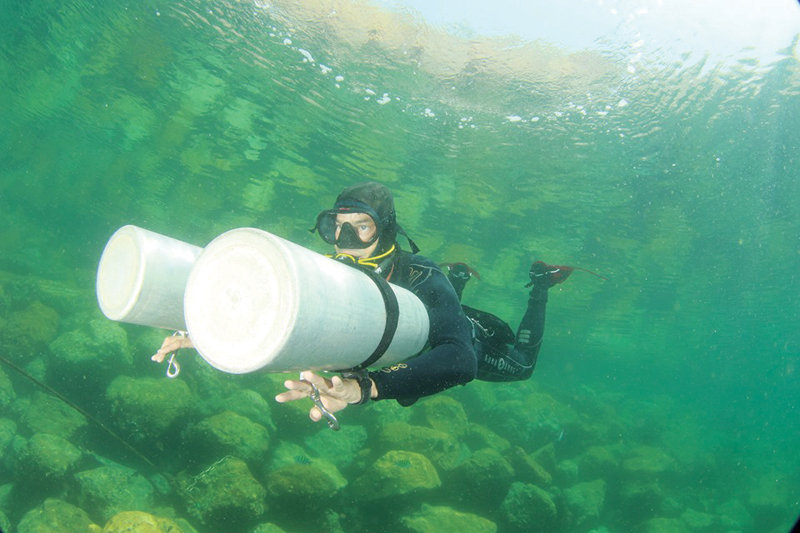






The Sultanate boasts of an impressive biodiversity with its abundance of rich marine life.
A top notch Italian professional diver, who works for Extra Divers at Mirbat, says divers can get crazy as they notice the same species with different colours.
Mirko Matto from Extra Divers Mirbat is a Scuba Schools International (SSI) training facility and he acts as a PADI instructor as well. SSI teaches the skills involved in scuba diving and free diving.
In a single dive one can easily spot about 4 to 5 different species of nudibranches (super colourful sea slugs), lobsters, schooling fish, rays, turtles, catfish, cuttlefish, razorfish, pineapple fish, toad fish and camouflage leave fish.
Though the corals here are not as rich as in other diving destinations, the marine life is abundant, and on some days when dives are really good, it may not be challenging and suitable for divers of every experience levels, says Mirko.
With a long and successful career, Mirko has been diving in many locations from Mediterranean and Red Sea, Maldives, Thailand, Similan Islands, Yucatan (Mexican state), Swiss, Italian lakes and rivers, Indonesia, Kenya, Oman, California and Cuba among others.
Mirko says Oman’s coral reefs offer fantastic landscape with incredibly many shoals and different kinds of morays, cuttlefish and rays.
Mirbat is famous for its kelp forests growing in summer due to cold water currents. In October/November they die and allow a view on riff-building table-and brain corals and especially on incredible amount of fish.
Turtles, blue-spotted, eagle and guitar rays are part of the marine life. Besides, there are different morays species including rare dragon morays. The variety of nudibranchs seems to be almost endless.
All diving sites reachable by boat are suitable for beginners as well as for advanced divers (6-40 metres at 20-130 feet), and they always try to adapt the degree of difficulty to fit guest ability and comforts.
From December dolphins are very often encountered not too far from the coast and from February several species of whales (including blue whales, Orcas, Sperm Whales, False Killer Whales and others) pass by and stop by for a while, probably because they find plenty of food for continuing their migration.
The local weather conditions in Mirbat during Khareef makes the area unique in the world: the heavy rains bring along nutrients from the land which happens only in the Sultanate because of the mountains that stop the humid air from the sea.
From May to October kelp (sea grass) grows creating a special underwater environment that goes on to last until February.
The humpback whales season starts by December-end and lasts for about three months. During this time, they can be watched from the boats on way to the diving sites.
In November there are good chances to watch dolphins’ schools which can be accompanied by boats from Extra Divers.
Mirko says Phytoplankton reproduction, algae blooms and corals spawning always affect underwater visibility. But thanks to nutrients dissolved in waters, there is an exceptional abundance of marine life and great health status of reefs.
“In Mirbat however, the underwater average temperature is almost constant during the whole year, and the reproduction of these creatures occur often which is according to delicate conditions such as water-pH, CO2/O2 balance, and other biological factors,” he adds.
Therefore, it is randomly occurring that the sea appears blue or green, the condition is not related to seasons but it is continuously changing, unpredictably.
When the water is really green and is rich in nutrients, they have the best underwater sightings while diving.
Mirko learnt scuba diving about 25 years ago mainly as a holiday or as a weekend diver. It was only few years later when he was living in Genova very close by the sea that he decided to became a dive guide.
He later decided to invest on the dive master course to have the chance to guide other divers and dive for free.
Says Mirko: “I fell in love with this lifestyle during a dive trip to Sharm El Sheikh when I met one of the best instructors ever who now is teaching cave diving in Yucatan. It was then I began wondering if I could live out of my passion. Once back, I decided and enrolled in the instructor course to have the chance to go abroad and work as diving trainer in the best destinations of the world.”
By the end of 2015 he moved back to recreational diving and joined Extra Divers Qantab for four years. He expanded his knowledge and skills and became boat captain, combined with diving techniques such as side mount diving consisting of two tanks at the sides instead of on the back.
After three years in Muscat, Extra Divers provided him opportunity to grow and to run one of their dive centres. Thus he was chosen to be the manager of Extra Divers Mirbat located at Kairaba Resort.
Oman Observer is now on the WhatsApp channel. Click here



